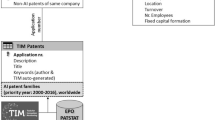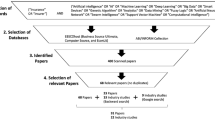Abstract
Technology convergence has been the subject of many prior studies, yet most have focussed on the structural patterns of convergence between a pair of technologies rather than the dynamic aspects of multi-technology convergence. This study proposes a machine learning approach to anticipating multi-technology convergence using patent information. For this, a patent database is first constructed using the United States Patent and Trademark Office database, distinguishing the primary class from other patent classes to consider the direction of multi-technology convergence. Second, association rule mining is employed to construct technology ecology networks describing the significant structural patterns of multi-technology convergence for different time periods in the form of a primary patent class → supplementary patent classes. Third, the technology ecology networks between the periods are compared to identify implications on the changing patterns of multi-technology convergence. Finally, link prediction analysis based on logistic regression models is utilised to provide insight into the prospects of multi-technology convergence by identifying the links to be added to or removed from the network. Based on this, we also discuss the characteristics of the proposed approach and the technological impact and uncertainty of the identified patterns of multi-technology convergence. The case of drug, bio-affecting, and body treating compositions technology is presented herein.





Similar content being viewed by others
Notes
According to the United States Patent and Trademark Office, every US patent has one and only one primary class (i.e. first bold class) that represents the main idea of invention described in the patent. It is double-vetted and reliable since the primary class is used for routing the application along the patent office. If there is a mistake in primary classification, the examiner will reject the patent, and it will be reclassified and routed to a different examiner (http://www.acclaimip.com/the-us-patent-classification-system-class-types/).
References
Adner, R. (2006). Match your innovation strategy to your innovation ecosystem. Harvard Business Review, 84(4), 98.
Adner, R., & Kapoor, R. (2010). Value creation in innovation ecosystems: How the structure of technological interdependence affects firm performance in new technology generations. Strategic Management Journal, 31(3), 306–333.
Agrawal, R., Imieliński, T., & Swami, A. (1993). Mining association rules between sets of items in large databases. ACM SIGMOD Record, 22(2), 207–216.
Aharonson, B. S., & Schilling, M. A. (2016). Mapping the technological landscape: Measuring technology distance, technological footprints, and technology evolution. Research Policy, 45(1), 81–96.
Athreye, S., & Keeble, D. (2000). Technological convergence, globalisation and ownership in the UK computer industry. Technovation, 20(5), 227–245.
Barberá-Tomás, D., Jiménez-Sáez, F., & Castelló-Molina, I. (2011). Mapping the importance of the real world: The validity of connectivity analysis of patent citations networks. Research Policy, 40(3), 473–486.
Bonchi, F., & Geothals, B. (2004). FP-Bonsai: The art of growing and pruning small fp-trees. In Pacific-Asia conference on knowledge discovery and data mining (pp. 155–160).
Caviggioli, F. (2016). Technology fusion: Identification and analysis of the drivers of technology convergence using patent data. Technovation, 55, 22–32.
Chaudhuri, S. (2005). The WTO and India’s pharmaceuticals industry: Patent protection, TRIPS, and developing countries. Oxford: Oxford University Press.
Chen, Y. S., & Chang, K. C. (2010). The relationship between a firm’s patent quality and its market value: The case of US pharmaceutical industry. Technological Forecasting and Social Change, 77(1), 20–33.
Choi, C., & Park, Y. (2009). Monitoring the organic structure of technology based on the patent development paths. Technological Forecasting and Social Change, 76(6), 754–768.
Curran, C. S., Bröring, S., & Leker, J. (2010). Anticipating converging industries using publicly available data. Technological Forecasting and Social Change, 77(3), 385–395.
Curran, C. S., & Leker, J. (2011). Patent indicators for monitoring convergence: Examples from NFF and ICT. Technological Forecasting and Social Change, 78(2), 256–273.
Dosi, G. (1984). Technical change and industrial transformation: The theory and an application to the semiconductor industry. Berlin: Springer.
Érdi, P., Makovi, K., Somogyvári, Z., Strandburg, K., Tobochnik, J., Volf, P., et al. (2013). Prediction of emerging technologies based on analysis of the US patent citation network. Scientometrics, 95(1), 225–242.
Fleming, L. (2001). Recombinant uncertainty in technological search. Management Science, 47(1), 117–132.
Fleming, L., & Sorenson, O. (2001). Technology as a complex adaptive system: Evidence from patent data. Research Policy, 30(7), 1019–1039.
Geum, Y., Kim, C., Lee, S., & Kim, M. S. (2012). Technological convergence of IT and BT: Evidence from patent analysis. ETRI Journal, 34(3), 439–449.
Granstrand, O., & Holgersson, M. (2020). Innovation ecosystems: A conceptual review and a new definition. Technovation, 90, 102098.
Gyorodi, C., Gyorodi, R., Cofeey, T., & Holban, S. (2003). Mining association rules using dynamic FP-trees. In Proceedings of irish signals and systems conference (pp. 76–81).
Hacklin, F., Battistini, B., & Von Krogh, G. (2013). Strategic choices in converging industries. MIT Sloan Management Review, 55(1), 65.
Hacklin, F., Marxt, C., & Fahrni, F. (2009). Coevolutionary cycles of convergence: An extrapolation from the ICT industry. Technological Forecasting and Social Change, 76(6), 723–736.
Hacklin, F., Raurich, V., & Marxt, C. (2005). Implications of technological convergence on innovation trajectories: The case of ICT industry. International Journal of Innovation and Technology Management, 2(3), 313–330.
Han, J., Cheng, H., Xin, D., & Yan, X. (2007). Frequent pattern mining: Current status and future directions. Data Mining Knowledge Discovery, 15(1), 55–86.
Harhoff, D., Scherer, F. M., & Vopel, K. (2003). Citations, family size, opposition and the value of patent rights. Research Policy, 32(8), 1343–1363.
Jang, H. J., Woo, H. G., & Lee, C. (2017). Hawkes process-based technology impact analysis. Journal of Informetrics, 11(2), 511–529.
Jeong, S., Kim, J. C., & Choi, J. Y. (2015). Technology convergence: What developmental stage are we in? Scientometrics, 104(3), 841–871.
Jiang, Q., & Luan, C. (2018). Diffusion, convergence and influence of pharmaceutical innovations: A comparative study of Chinese and US patents. Globalization and Health, 14(1), 92.
Karki, M. M. S. (1997). Patent citation analysis: A policy analysis tool. World Patent Information, 19(4), 269–272.
Kim, E., Cho, Y., & Kim, W. (2014). Dynamic patterns of technological convergence in printed electronics technologies: Patent citation network. Scientometrics, 98(2), 975–998.
Kim, H., Hong, S., Kwon, O., & Lee, C. (2017). Concentric diversification based on technological capabilities: Link analysis of products and technologies. Technological Forecasting and Social Change, 118, 246–257.
Kim, J., Kim, S., & Lee, C. (2019). Anticipating technological convergence: Link prediction using Wikipedia hyperlinks. Technovation, 79, 25–34.
Kim, J., & Lee, S. (2017). Forecasting and identifying multi-technology convergence based on patent data: The case of IT and BT industries in 2020. Scientometrics, 111(1), 47–65.
Kim, N., Lee, H., Kim, W., Lee, H., & Suh, J. H. (2015). Dynamic patterns of industry convergence: Evidence from a large amount of unstructured data. Research Policy, 44(9), 1734–1748.
Kim, C., Lee, H., Seol, H., & Lee, C. (2011). Identifying core technologies based on technological cross-impacts: An association rule mining (ARM) and analytic network process (ANP) approach. Expert Systems with Applications, 38(10), 12559–12564.
Kwon, O., An, Y., Kim, M., & Lee, C. (2020). Anticipating technology-driven industry convergence: Evidence from large-scale patent analysis. Technology Analysis and Strategic Management, 32(4), 363–378.
Lee, C., Cho, Y., Seol, H., & Park, Y. (2012). A stochastic patent citation analysis approach to assessing future technological impacts. Technological Forecasting and Social Change, 79(1), 16–29.
Lee, W. S., Han, E. J., & Sohn, S. Y. (2015a). Predicting the pattern of technology convergence using big-data technology on large-scale triadic patents. Technological Forecasting and Social Change, 100, 317–329.
Lee, C., Kang, B., & Shin, J. (2015b). Novelty-focused patent mapping for technology opportunity analysis. Technological Forecasting and Social Change, 90, 355–365.
Lee, C., Kwon, O., Kim, M., & Kwon, D. (2018). Early identification of emerging technologies: A machine learning approach using multiple patent indicators. Technological Forecasting and Social Change, 127, 291–303.
Lee, C., & Lee, G. (2019). Technology opportunity analysis based on recombinant search: Patent landscape analysis for idea generation. Scientometrics, 121(2), 603–632.
Liu, G., Lu, H., Yu, J. X., Wang, W., & Xiao, X. (2003). AFOPT: An efficient implementation of pattern growth approach. In Proceedings of ICDM workshop on frequent itemset mining implementations.
Narin, F., Noma, E., & Perry, R. (1987). Patents as indicators of corporate technological strength. Research Policy, 16(2–4), 143–155.
No, H. J., & Park, Y. (2010). Trajectory patterns of technology fusion: Trend analysis and taxonomical grouping in nanobiotechnology. Technological Forecasting and Social Change, 77(1), 63–75.
Oh, D. S., Phillips, F., Park, S., & Lee, E. (2016). Innovation ecosystems: A critical examination. Technovation, 54, 1–6.
Powers, D. M. (2011). Evaluation: From precision, recall and F-measure to ROC, informedness, markedness and correlation. Journal of Machine Learning Technologies, 2(1), 37–63.
Shih, M. J., Liu, D. R., & Hsu, M. L. (2010). Discovering competitive intelligence by mining changes in patent trends. Expert Systems with Applications, 37(4), 2882–2890.
Shin, J., Coh, B. Y., & Lee, C. (2013). Robust future-oriented technology portfolios: Black–Litterman approach. R&D Management, 43(5), 409–419.
Xu, G., Wu, Y., Minshall, T., & Zhou, Y. (2018). Exploring innovation ecosystems across science, technology, and business: A case of 3D printing in China. Technological Forecasting and Social Change, 136, 208–221.
Youden, W. J. (1950). Index for rating diagnostic tests. Cancer, 3(1), 32–35.
Acknowledgements
This work was supported by the National Research Foundation of Korea (NRF) grants funded by the Korean government (MSIP) (No. 2019R1A6A3A13096839) and and the Sogang University Research Grant of 2020 (No. 202010009.01).
Author information
Authors and Affiliations
Corresponding author
Appendices
Appendix 1: An example of constructing a technology ecology network
We present a step-by-step example of constructing a technology ecology network describing the significant structural patterns of multi-technology convergence. Five patents are used in this example, as shown in Table 8, and the threshold values for CP and CI are set to 0.2 and 0.5.
First, we identify frequently co-occurred structural patterns based on the Apriori algorithm. Specifically, the frequent individual primary and supplementary classes (i.e. one-item set) that exceed the prescribed threshold values for CP (i.e. 0.2) are identified; the frequent patterns with one primary class and one supplementary class (i.e. two-item set) are identified from the one-item set; the two-item set is extended to the three-item set with one primary class and two supplementary classes by adding one supplementary class at a time. This extension process terminates when no further extensions are found. Table 9 shows the results of Apriori algorithm employed in this study, where the frequently co-occurred structural patterns derived from the five patents are highlighted in bold.
Next, we compute the values of CI and CS for the frequently co-occurred patterns, as shown in Table 10. Three patterns are identified as significant as their CI and CS values are greater than the threshold value for CI (i.e. 0.5) and one, respectively.
Finally, the significant structural patterns are represented as the technology ecology network. In Fig. 5, a source and a target node are a primary class and supplementary classes; the size of a node represents the number of the corresponding pattern’s occurrence; a link represents the CI among the associated classes. White and grey nodes denote single and multiple patent classes; blue and red links indicate within-technology convergence where the primary patent class also appears in the supplementary patent class part and between-technology convergence where the primary patent class is not included in the patent class segment, respectively.
Appendix 2
See Table 11.
Rights and permissions
About this article
Cite this article
Lee, C., Hong, S. & Kim, J. Anticipating multi-technology convergence: a machine learning approach using patent information. Scientometrics 126, 1867–1896 (2021). https://doi.org/10.1007/s11192-020-03842-6
Received:
Accepted:
Published:
Issue Date:
DOI: https://doi.org/10.1007/s11192-020-03842-6





